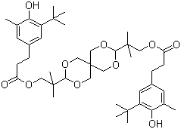Address:Room 906, building 6, SIIC Center, No.195 Hong Kong East Road, Laoshan District, Qingdao city, Shandong Province, China
E-mail:info@deltachem.net

Conventional hindered phenol antioxidants are also known as symmetrically hindered phenol antioxidants, i.e., they have the same two substituents in the neighboring positions of the phenolic hydroxyl group. In this case, the phenolic hydroxyl group has a large spatial site resistance, its reactivity is small, and the plastic products are easy to be colored when NOx is present in the production and storage environment.
v What’s the asymmetric hindered phenol antioxidant? What are the advantages of this type of antioxidants?
The asymmetric hindered phenol antioxidant has a small molecular weight group in one of its neighboring positions, which weakens the site resistance of the hydroxyl group and accelerates the antioxidant reaction. Asymmetric hindered phenol antioxidants not only have the functions of general hindered phenol antioxidants, but also the synergistic stabilizing effect with auxiliary antioxidants and the coloring resistance is more prominent than that of traditional symmetric hindered phenols.
Some researchers used coloring experiments to evaluate the color stability of hindered phenol antioxidants. The researchers placed the powder antioxidant in NO2 at room temperature, and after a period of time observed whether the antioxidant showed a color change (usually reddening), and found that the asymmetric hindered phenol antioxidants were more stable in color compared to the symmetric hindered phenol antioxidants (e.g., AN1010, AN1076).

Chemical structure of hindered phenolic antioxidant
v The asymmetric hindered phenolic antioxidants we supply:
OMNISTAB AN245 is a kind of asymmetric hindered phenol antioxidant, which has a special structure that its hydroxyl ortho R1 and R2 are two different substituents, R1 is tert-butyl, R2 is methyl.

Chemical structure of OMNISTAB AN245
The special structure of OMNISTAB AN245 could weaken the space steric hindrance, and the conjugated system of oxygen free radical and benzene ring can exist stably after providing protons, the improved reactivity of its phenolic hydroxyl can make it easy to provide active H atom and then combine with peroxy radical. Therefore, the speed of antioxidation reaction is accelerated and the stability efficiency of thermal oxygen is improved.
The problem of the discoloration and fading of plastic products are of great concern to many manufacturers, and the discoloration and fading of products have a closed relationship with the heat resistance, oxygen resistance, color stability of the antioxidant!
OMNISTAB AN245 is currently widely used in PS, PU, HIPS, ABS, MBS, POM and SB and SBR latex emulsions.

Chemical structure of OMNISTAB AO-80
Besides AN245, OMNISTAB AO-80 is an asymmetric hindered phenol antioxidant with a higher molecular weight, lower volatility and better resistance to gas fading.
OMNISTAB AO-80 is suitable for some high temperature processing plastics systems (above 200°C).
OMNISTAB AO-80 has better heat aging resistance when used in synergy with phosphite-based antioxidants and sulfur-based antioxidants. AO-80 is widely applied in polyolefins and various elastomers, especially for PA, PUR, PE, POM, PP.